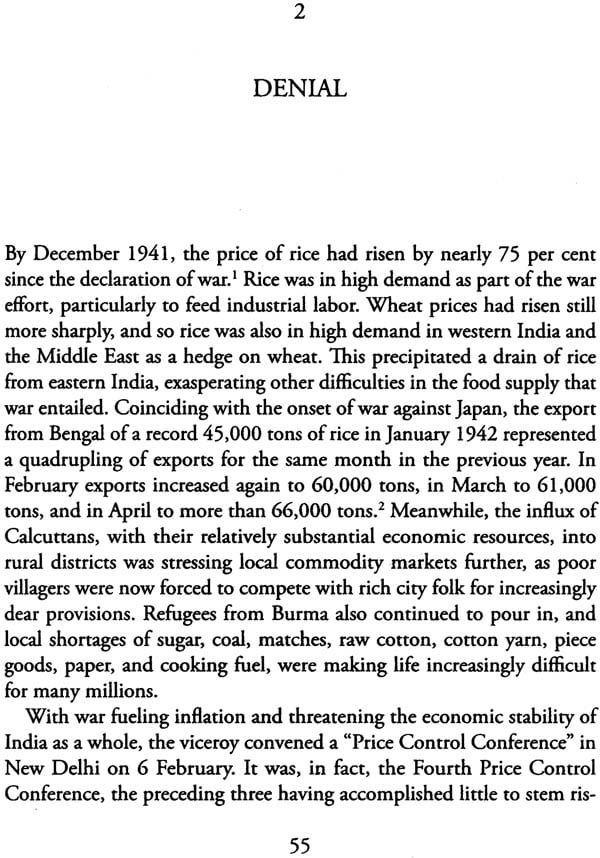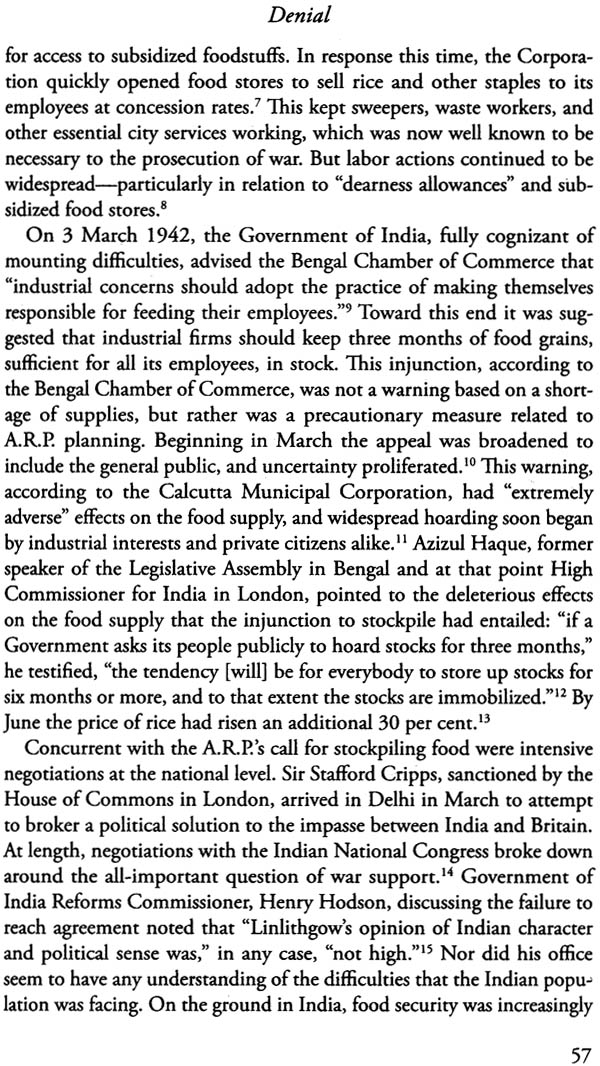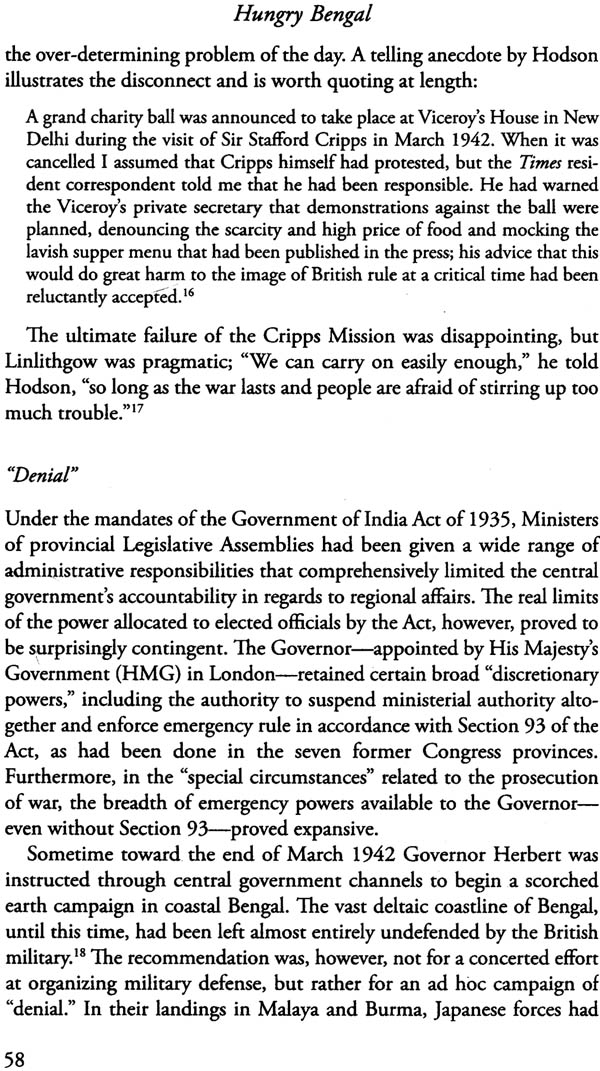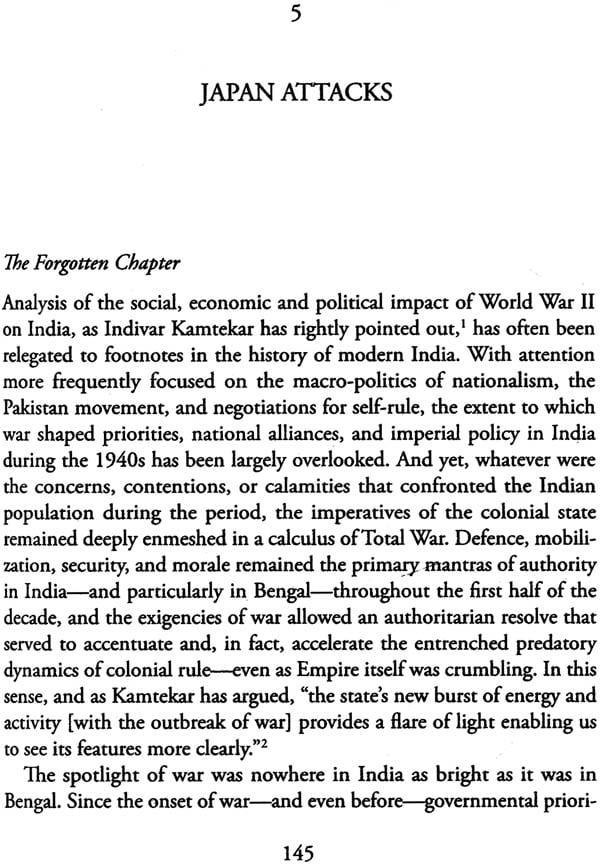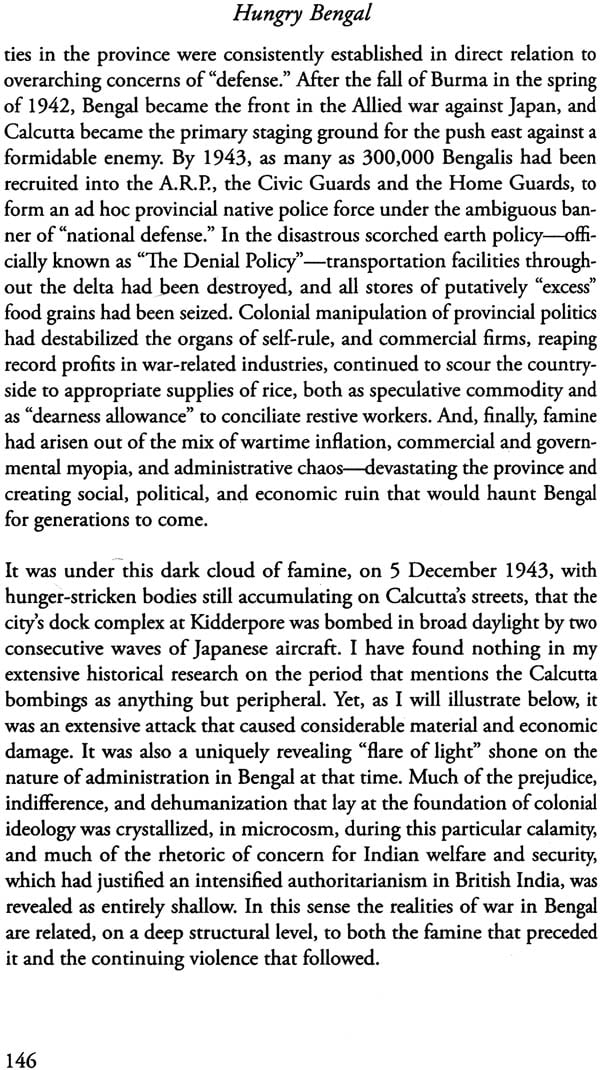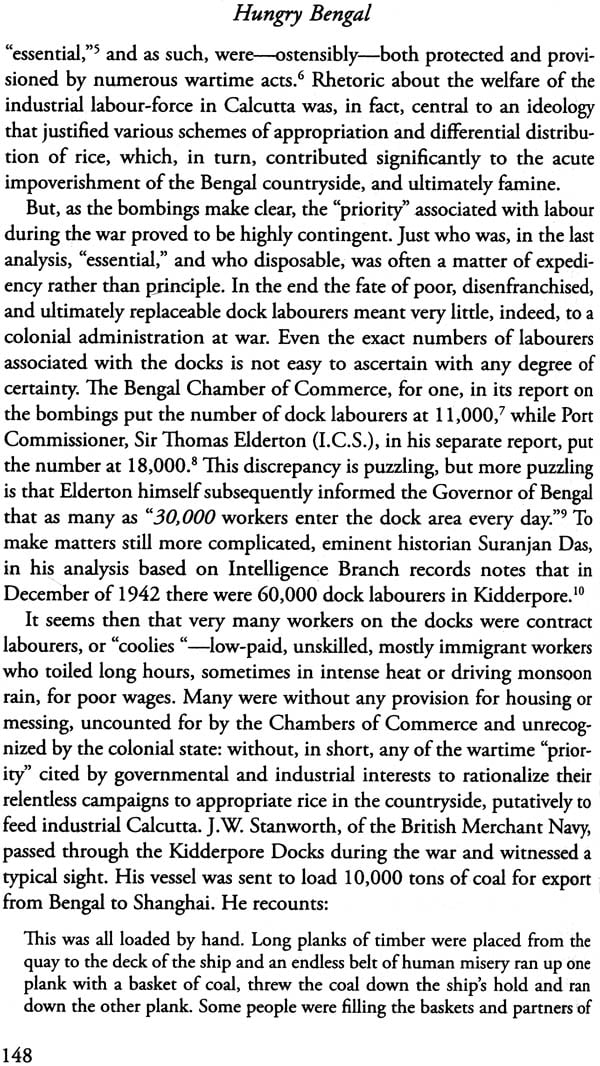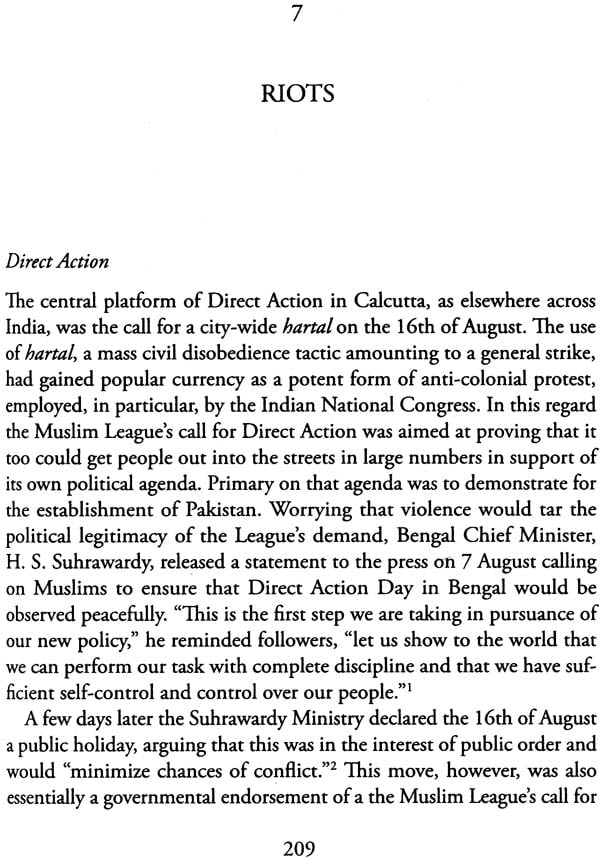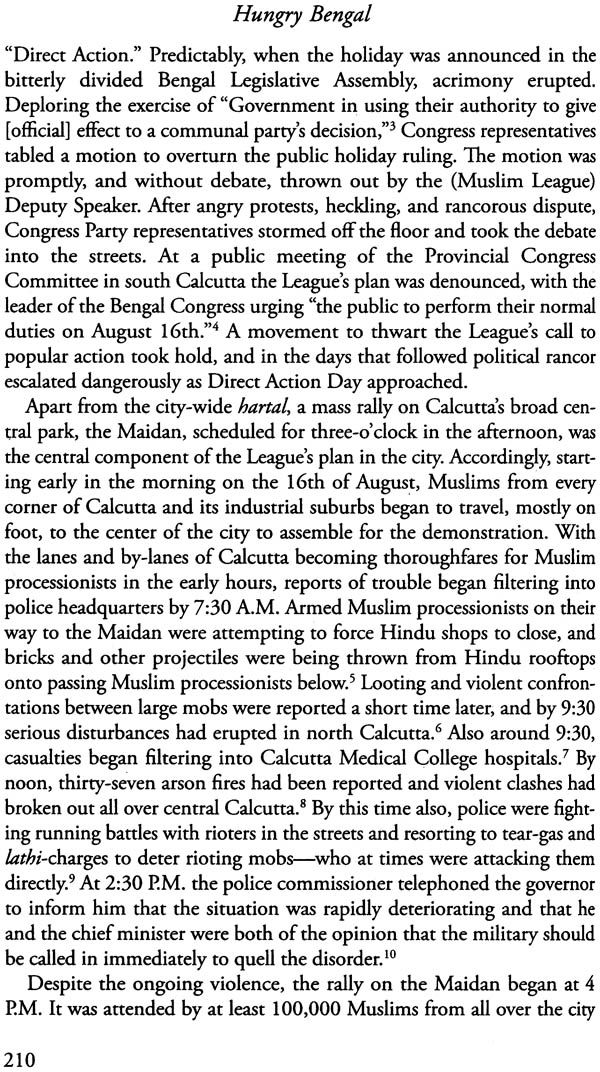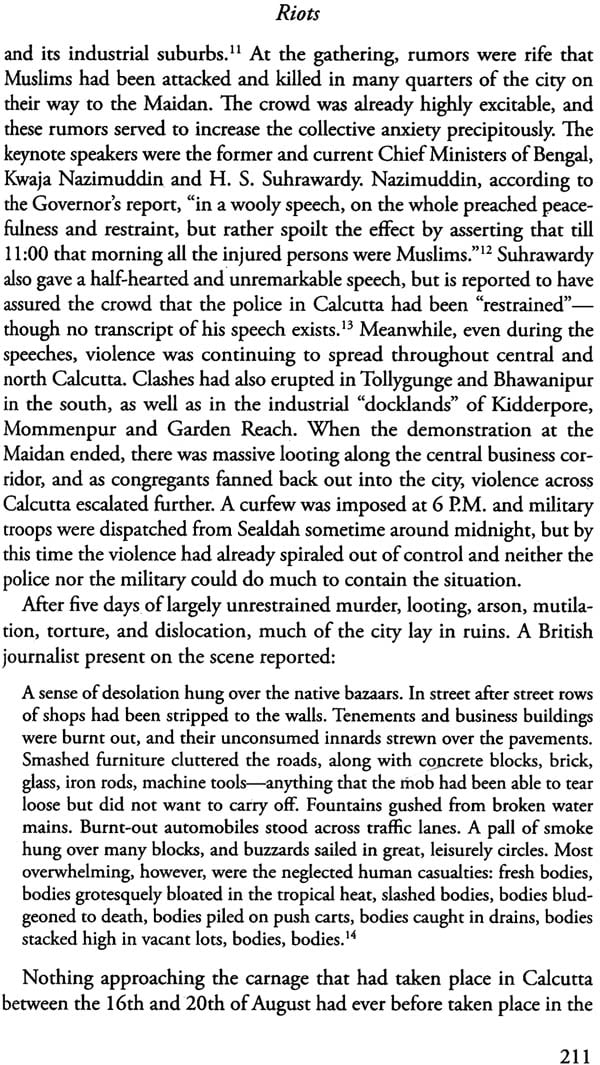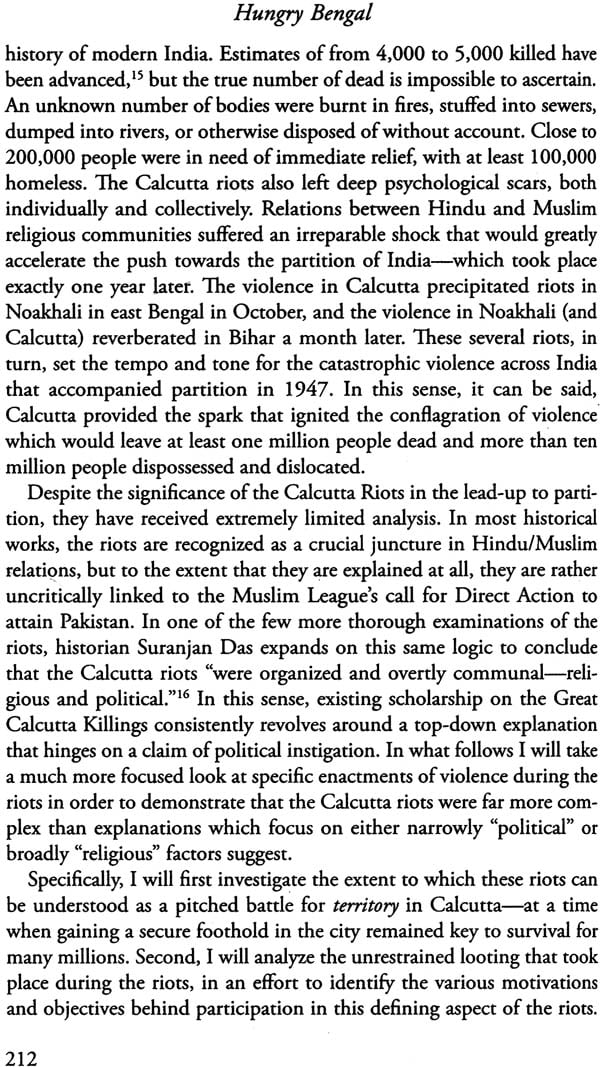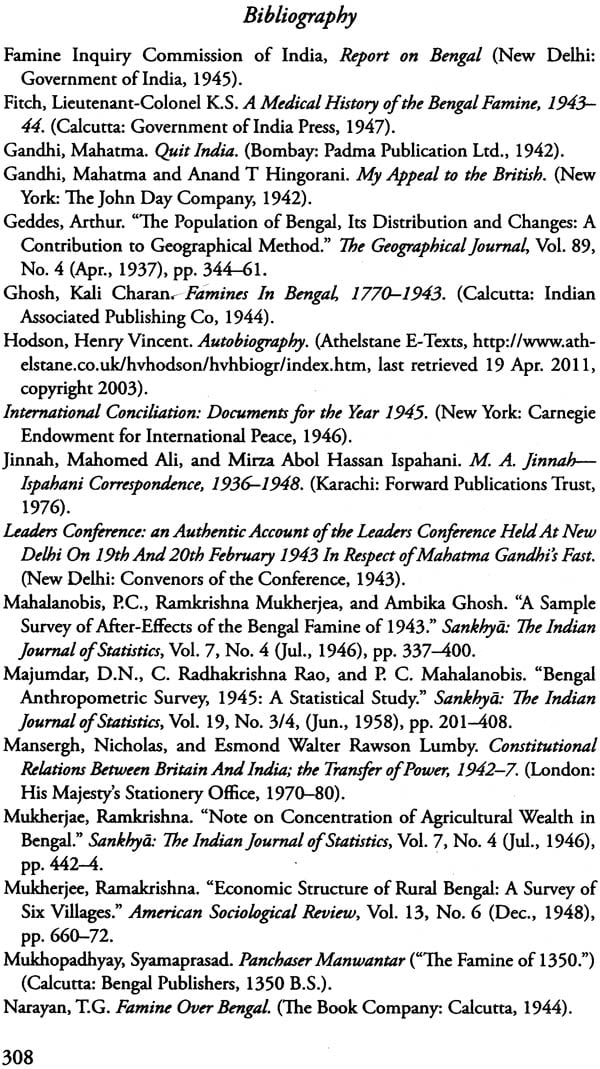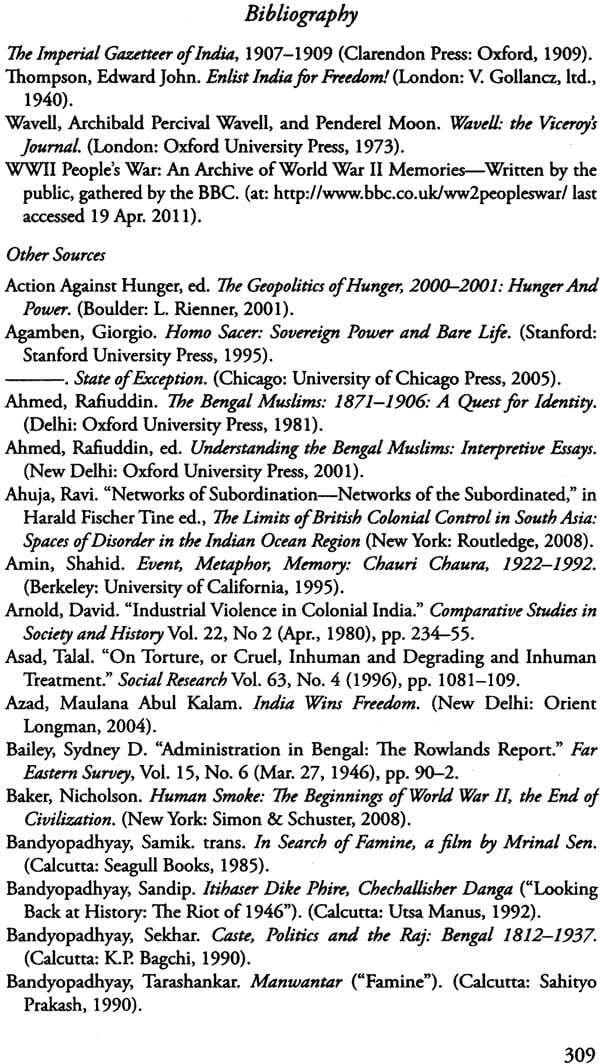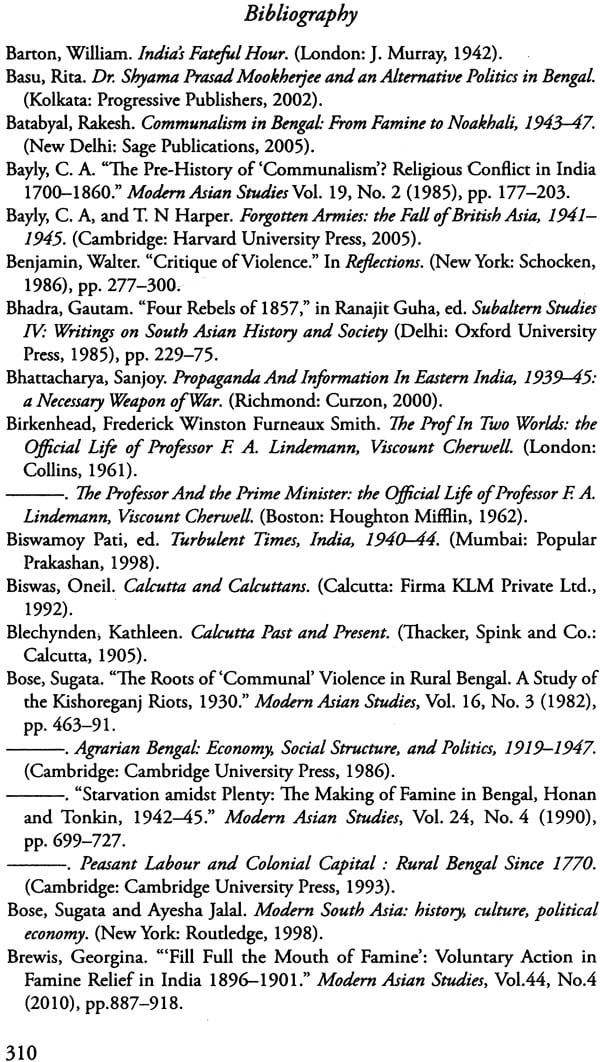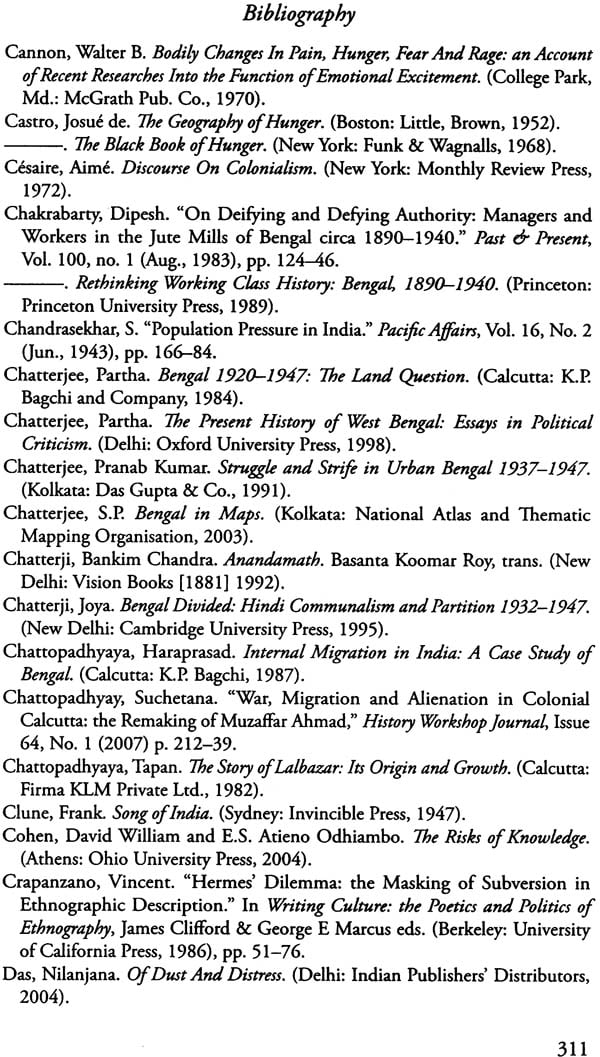
Hungry Bengal (War, Famine, Riots and The End of Empire)
Book Specification
| Item Code: | NAL589 |
| Author: | Janam Mukherjee |
| Publisher: | Harper Collins Publishers |
| Language: | English |
| Edition: | 2015 |
| ISBN: | 9789351775829 |
| Pages: | 345 |
| Cover: | Paperback |
| Other Details | 8.5 inch x 5.5 inch |
| Weight | 290 gm |
Book Description
The years leading up to the independence and accompanying partition of India mark a tumultuous period in the history of Bengal. Representing both a major front in the Indian Struggle against colonial rule, as well as crucial Allied outpost in the British/American war against Japan, Bengal stood at the crossroads of complex and contentious structural forces-both domestic and international-which, taken together, defined an era of political uncertainty, social turmoil and collective violence. While for the British the overarching priority was to save the empire from imminent collapse at any cost, for the majority of the Indian population the 1940s were years of acute scarcity, violent dislocation and enduring calamity. In particular there are three major crises that shaped the social, economic and political context of pre-partition Bengal: the Second World War, the Bengal famine of 1943, and the Calcutta riots of 1946. Hungry Bengal examines these intricately interconnected events, foregrounding the political economy of war and famine in order to analyse the complex nexus of hunger, war and civil violence in colonial at the twilight of British rule.
Framing Famine
There will be no pictures of emaciated mothers with child in this book on famine. I will not be looking to elicit pity, or to evoke a sense of charity. Even in the search for empathy, the existential bridges that would be necessary to cross are impossibly broad, ultimately impassible. There are no such bridges. Famine preys on the poorest of the poor, the weakest of the weak, those whose very lives and life-stories are erased by marginality and neglect. Startling and/or demise, however moving, convey very little about the structures of inequality and injustice that define that most famines. Famine, in the vast majority of cases, represents a complex form of human violence that merits much closer attention. It is not enough to gawk at the human wreckage that famine leaves in its wake. In all famines beasts of prey await the human carrion which is generated by brutal indifference, inequality and the Manichean mechanics of power. Instead we need to look intently into mechanics, examining the structures and processes that bring about and perpetuate famine, rather than gaping at the work of hungry vultures in belated dread. To really know famine-and in this sense to imagine the possibility of its prevention-it is better to rigorously examine working of mass starvation than to construct emotional to the dead and dying. In this spirit it is my goal here to investigate the tightly wrought structures of influence and indifference that gave birth to famine in mid-twentieth century Bengal; to unfold the dialectics of power and powerlessness-from the local to the global-that defined the trajectory of famine; and to trace the protracted and highly divisive consequences of a catastrophe that scarred the landscape of India for generations to come.
To date, historiography of India on the eve of independence has focused most often on the nationalist struggle, negotiations for a transfer of power, the maneuvering of the Indian National Congress and the Muslim League and/or the rise of communal rancor-all charred according to the irreducible teleology of eventual independence and the partition of the sub-continent into distinct state entities, India and Pakistan. In short, the history of India in the 1940s has been trapped in the nationalist mode. The deleterious effects of world The deleterious effects of world war have been relegated to footnotes or brief articles, and famine in Bengal has been removed from the course of event for occasional, if isolated, inspection. My objective here is to address this oversight and to demonstrate in clinical detail the deep and abiding impacts that both war and famine had on the course of event in India on the verge of independence. Famine in Bengal is not simply the story of a woeful human tragedy, it is just as importantly the story of how annihilating inequality and material deprivation both stem from and impact identifiable structures of power. The goal in this sense, is to return famine to the wider course of event and to illustrate that, far from being a side story for special study, the Bengal famine should be understood as central to the history of twentieth-century India and even global history. In this effort it might be possible to imagine that I am also attempting to restore the story of the most marginalized to the mainstream of history-even if in relief-as the story of the Bengal famine is in some definite definite sense their story.
Since the 1940s, scholarship on the Bengal famine has mostly focused on identifying the various “causes” of its occurrence. Famine is understood as a sort of historical aberration that needs to be explained. The complex political, economic, psychological and social forces that have been identified as causal in these several works, however, have never been narrated in full or analyzed in interrelated detail. Similarly, the effects that famine had on the politics and society of Bengal, and its deep entanglements in the broader history of India, have been largely ignored. On the other hand, in works dealing with modern Indian history writ large, the Bengal famine commonly receives a paragraph or two of mention. Because of its perceived nature as merely a humanitarian ian tragedy, perhaps, the extent to which famine impacted the wider historical context of pre- Independence India has gone largely unexam ined. Or maybe it is the very marginality of the victims of famine that make it side story in histories that more commonly focus on the activities it a side story in histories that more commonly focus on the activities of great men. Whatever the exact reasons, until now, the complex political economy of famine in Bengal has received scant attention. But can it be that the mechanisms of power and exclusion that led to the annihilation of at least three million souls remain this marginal to the larger history of a nation in the making?
If not recognized as central to an understanding of mid-twentieth-century South Asian history as a whole, however, the Bengal famine has yet provided rich ground for important scholarly analysis. Most famously, in 1980, economist Amartya Sen published his seminal work Poverty and Famines, using the Bengal famine as a central example. Having grown up in Bengal during the 1940s himself, it is no wonder that famine has formed the cornerstone of his illustrious career. In poverty and Famines Sen famously argued that, “Starvation is the characteristic of some people not having enough to eat. It is not the characteristic of there being not enough to eat. While the latter can be the cause of the former, it is but one of many possible causes.” That is; it is not enough to assume that famine indicates an actual shortage of food, all famine necessarily indicates is that certain of a given population are-for one reason or another-forced to go without. In several respects the Bengal famine proved the perfect case study to substantiate this theory. Through a careful examination of the official record, Sen concluded that starvation, in this case, clearly resulted not from an overall deficit of food, but rather from sharp wartime inflation in India that the poor of Bengal unable to Purchase rice. This conclusion-that famine in Bengal resulted from a circumstance in which the poor starved because they had become acutely economically disadvantaged, not from circumstance in which food was simply not available-might today seem somewhat intuitive, but at the time is was revolutionary enough to win him a Nobel Prize in economics.
| Acknowledgements | xi | |
| Map | xiii | |
| Introductio: In Search of Famine | 1 | |
| Framing Famine | 1 | |
| Total War | 7 | |
| "The Bengal Famine of 1943" | 11 | |
| The Calcutta Riots | 16 | |
| Perspective | 19 | |
| 1 | War | 23 |
| Food Security | 25 | |
| Enforcing Morale | 30 | |
| Hearts and Minds | 36 | |
| The Countryside | 38 | |
| Establishing Priorities | 41 | |
| The Fortress Falls | 43 | |
| Burmese Days | 46 | |
| Nobody's Home | 47 | |
| Provincial Politics and War | 49 | |
| 2 | Denial | 55 |
| "Denial" | 58 | |
| The Denial Resolution | 67 | |
| Quit India | 71 | |
| Economic Warfare | 74 | |
| Storm | 78 | |
| Christmas in Calcutta | 81 | |
| 3 | Priorities | 85 |
| The "Steel Frame" | 87 | |
| Imports | 92 | |
| Starving Indians | 94 | |
| Hunger Artist | 99 | |
| De-control | 102 | |
| Section 93 | 103 | |
| The Scramble for Rice | 106 | |
| Abandoning the Basic Plan | 109 | |
| 4 | Famine | 115 |
| Food Drive | 116 | |
| Last Ditch Denials | 121 | |
| "Famine" | 125 | |
| Starvation | 128 | |
| "Sick Destitutes" | 131 | |
| Round-ups and Resistance | 134 | |
| Bengal in Ruins | 138 | |
| The Good Viceroy | 140 | |
| 5 | Japan Attacks | 145 |
| The Forgotten Chapter | 145 | |
| The Port of Calcutta | 150 | |
| Japan Attacks | 156 | |
| Damage Control | 157 | |
| Bodies | 163 | |
| Settling Accounts | 163 | |
| Air Raid Damage | 167 | |
| 6 | Second Famine | 171 |
| Ending Famine | 172 | |
| Whose amine? | 175 | |
| Governing Bengal | 181 | |
| Imports | 184 | |
| Famine Enquiry | 188 | |
| Politics | 192 | |
| The Lean Season | 196 | |
| Disturbances | 200 | |
| Second Famine | 202 | |
| 7 | Roiots | 209 |
| Direct Action | 209 | |
| Territory | 213 | |
| Loot | 221 | |
| Labor | 227 | |
| Anti-Colonialism and Administrative Collapse | 234 | |
| Bodies | 239 | |
| Communalism | 246 | |
| Conclusion | 251 | |
| Notes | 263 | |
| Bibliography | 305 | |
| Index | 317 |
